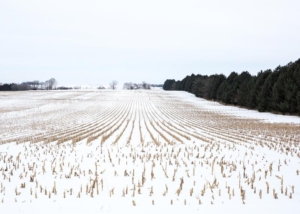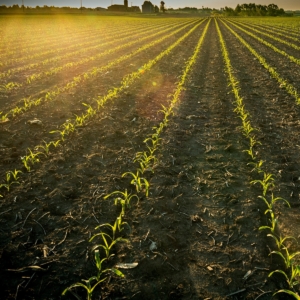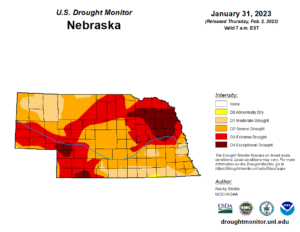MID-WINTER AGRONOMY UPDATE – February 7, 2023….
Mid-Winter Update:
While currently, our fields look like this….

It won’t be long and our fields will look like this….

No matter if we have six more weeks of winter or not, spring is on its way. At least the weather pattern as far as moisture is concerned seems to have changed from last year, which is a positive heading into the 2023 growing season! Current trends are that we are transitioning from a La Nina to a potential El Nino climate pattern…no matter what happens, we know this year will be different than last year….
Topics
- Current Drought Monitor Map
- Latest ‘chatter’ on proposed changes to Xtend herbicide label
- Enlist E3 Soybeans and Best Management Practices/Corteva Crop Protection Prepay
- New Lumiscend Pro Fungicide Seed Treatment for Corn
- Articles of Interest….
Current Drought Monitor Map

The above map is the current Drought Monitor Map for Nebraska as of January 31, 2023. Even though we have received above normal precipitation for December and January, we are very much still in an extreme drought position. Thankfully, it appears our weather pattern has changed for the better, but we will need a lot of rainfall to correct this. Historical patterns show about a 2-3 year time frame before we see drought conditions expire.
EPA to Rule in mid-February on Proposed Changes to Xtend Herbicide Label?….
There has been a lot of ‘chatter’ this past week on possible proposed changes to the Xtend Herbicide label from EPA. The ‘chatter’ talks of a substantially earlier cutoff date of mid-June for the last application of Xtend versus the current cutoff date of June 30. If so, this may change your herbicide plans. The final ruling from the EPA is supposed to come out around the middle of February. While all of this could be just ‘noise’, we want you to be aware of potential changes as this may impact your plans for 2023. We also want to let you know we still have a good supply of both Enlist E3 and Xtend soybeans.
Enlist E3 Soybeans & Best Management Practices

Enlist E3 soybean acres have grown in the area for 2023. As such, we want to review again the features and benefits of the Enlist E3 system and update yield information on Pioneer E3 soybean varieties. A reminder that Enlist E3 can be tank mixed with Liberty herbicide for increased waterhemp/palmer control under heavy populations. From our experience and observations, a post-application of Liberty as a stand-alone product will not provide adequate weed-control.
Making the Move to the Enlist Herbicide System
- Features
- Benefits
- Tips
Let’s begin with the features that may unintentionally get glossed over.
- This isn’t your average every day 2,4-D…it has super beneficial powers such as:
-
- Near-Zero volatility; Enlist One (2,4-D choline) = more stabile
- 96% reduction verses ester
- 87.5% reduction verses amine
- On an acid-to-acid basis 236X less volatile than dicamba
- Near-Zero volatility; Enlist One (2,4-D choline) = more stabile
-
- Colex-D® technology is present in Enlist One herbicide to reduce physical drift = no need to add a DRA(drift reducing agent)
- When used with low drift nozzles, physical drift potential is reduced by 90% compared to:
- Tank-mixtures of traditional 2,4-D and glyphosate
- When used with low drift nozzles, physical drift potential is reduced by 90% compared to:
- Colex-D® technology is present in Enlist One herbicide to reduce physical drift = no need to add a DRA(drift reducing agent)
The benefits are much easier to spot.
- Superior Flexibility
- No DRA’s or Volatility reducing agent’s are needed for application
- Labeled AMS can be added, many choices in adjuvants, and 1,000 approved tank-mix partners
- YES, can be tank-mixed with Liberty herbicide
- No buffer is required when the wind is blowing away from sensitive areas
- Only a 30-ft buffer is required when the wind is blowing toward sensitive areas = more treatable acres
- No cutoff dates for applications
- Through R1 soybean growth stage
- Less that can inadvertently go wrong
- Soybeans are 23X more tolerant to 2,4-D than dicamba
Important Tips For Your Success.
- Use a PRE herbicide with 2 effective SOA
- Important for all herbicide systems
- Helps improve POST herbicide coverage & slows down weed resistance
- Select the appropriate nozzle to maximize weed coverage
- Increasing water volume (gpa) alone will not replace having the correct nozzles
- Examples:
- TTI nozzle (ultra-coarse) – going from 10 gpa to 20 gpa = 3% improvement in coverage
- AIXR nozzle (coarse) – 10 gpa to 20 gpa = 6% improvement
- Examples:
- Preferred nozzles include:
- AIXR 11004, 05, 06, 08, 010
- AITTJ 110-04, 05, 06, 08, 10
- MR 110-06, 08, 10, and 125
- Increasing water volume (gpa) alone will not replace having the correct nozzles
- Do Not pour glyphosate products into the inductor or spray tank at the same time as Enlist One
- Pouring them in together will result in the formation of chunks; pour separate & allow time for agitation
- Make sure the sprayer system is thoroughly cleaned before transitioning to Enlist herbicide applications
- Be mindful of increasing use of dicamba with preemergence corn herbicides
- Clean Sprayer, transfer truck/trailers, shuttles
- Tanks, pumps, booms, hoses, filters, screens, nozzles, endcaps
- TruChoice® Prepay
- Earn upfront savings on Enlist One Herbicide & other Corteva PRE & POST residuals
- Pioneer acre = 15% Cash
-
-
- Minimum of $5,000
- Deadline February 24, 2023
-
The link below has the latest on Pioneer Enlist E3 soybean yield information and variety characteristics:
Pioneer Enlist E3 Soybean Yield and Characteristics for 2023
Pioneer Lumiscend Pro Fungicide Seed Treatment for Corn
Lumiscend Pro Fungicide is the latest from Pioneer for seed treatment on corn. It is the same current, industry-standard treatment, but with a new active ingredient that provides systemic protection against Rhizoctonia and Fusarium spp. The Lumigen Seed Treatment from Pioneer for corn now has five active ingredients and 9 MOA for protection against Pythium, Rhizoctonia, and Fusarium. No other seed treatment in the industry has this many AI’s and MOA’s. Lumigen Seed Treatment also contains Lumialza insecticide/nematicide for control of seed-attacking pests and corn nematode protection. More info in the links below….
Lumiscend Pro Fungicide Tech Sheet
Lumigen Fungicide Seed Treatment on Corn
Articles of Interest….
Corn for grain production in Nebraska based on year-end surveys is estimated at 1.46 billion bushels, down 22% from 2021, according to the USDA’s National Agricultural Statistics Service. Yield of 165 bushels per acre is down 29 bushels from last year. Farmers harvested 8.82 million acres of corn for grain, down 8% from 2021. Corn for silage production is 5.38 million tons, up 6% from last year. Silage yield of 12.5 tons per acre is down 7.0 tons from last year. Corn for silage harvested acreage of 430,000 acres is up 170,000 acres from last year. Corn acreage planted for all purposes is 9.60 million acres, down 3% from last year.
Soybean production for 2022 totaled 278 million bushels, down 21% from 2021. Yield, at 49.0 bushels per acre, is down 14.0 bushels from a year earlier. Area for harvest, at 5.68 million acres, is up 2% from 2021. Planted acreage totaled 5.75 million acres, up 3% from last year.
Sorghum for grain production in 2022 is estimated at 6.88 million bushels, down 65% from 2021. Yield, at 55.0 bushels per acre, is down 31.0 bushels from a year earlier. Area harvested for grain, at 125,000 acres, is down 46% from 2021. Sorghum for silage production is 698,000 tons, up 55% from last year. Silage yield of 9.3 tons per acre is down 5.2 tons from last year. Sorghum for silage harvested acreage of 75,000 acres is up 44,000 acres from last year. Sorghum acreage planted for all purposes is 320,000 acres, unchanged from last year.
Alfalfa hay production, at 2.45 million tons, is down 34% from a year earlier. The average yield, at 3.10 tons per acre, is down 1.00 ton per acre from 2021. Area harvested, at 790,000 acres, is down 13% from 2021. Alfalfa haylage and greenchop production, at 68,000 tons, is down 35% from last year. Average yield, at 2.70 tons per acre, is down 1.50 tons per acre from last year. Area harvested, at 25,000 acres, is unchanged from last year. Seedings of alfalfa during 2022 totaled 110,000 acres, up 20,000 acres from a year earlier.
All other hay production, at 1.89 million tons, is down 26% from last year. The average yield, at 1.40 tons per acre, is down 0.15 ton per acre from last year. Area harvested, at 1.35 million acres, is down 18% from 2021. All other haylage and greenchop production, at 200,000 tons, is down 9% from last year. Average yield, at 4.00 tons per acre, is down 4.80 tons per acre from last year. Area harvested, at 50,000 acres, is up 25,000 acres from last year.
Proso millet production in 2022 is estimated at 1.73 million bushels, down 55% from last year’s production. Yield, at 15.0 bushels per acre, is down 9.0 bushels from a year earlier. Area harvested for grain, at 115,000 acres, is down 27% from 2021. Area planted, at 145,000 acres, is down 12% from last year.
More on this report here.
Interesting video on how Pioneer Tests for Brittle Snap…
Nice summary of US Historical Grain Yields and the impact of the different technologies over the era’s.
Historical Corn Grain Yields 1866-2022
New research from Purdue University Agronomy on corn response to starter fertilizer….reiterates what we have always known…
Corn Response to Starter Fertilizer – Purdue 2023
Pioneer ‘Crop Shop’ Agronomy Meeting
Please mark your calendar for the Pioneer ‘Crop Shop’ Agronomy Meeting, which is scheduled for Wednesday, March 8th. More info and invitation will follow.
As always, THANK YOU for your business and support! Stay safe during the rest of this winter!
Starman Seed Service, Inc.

